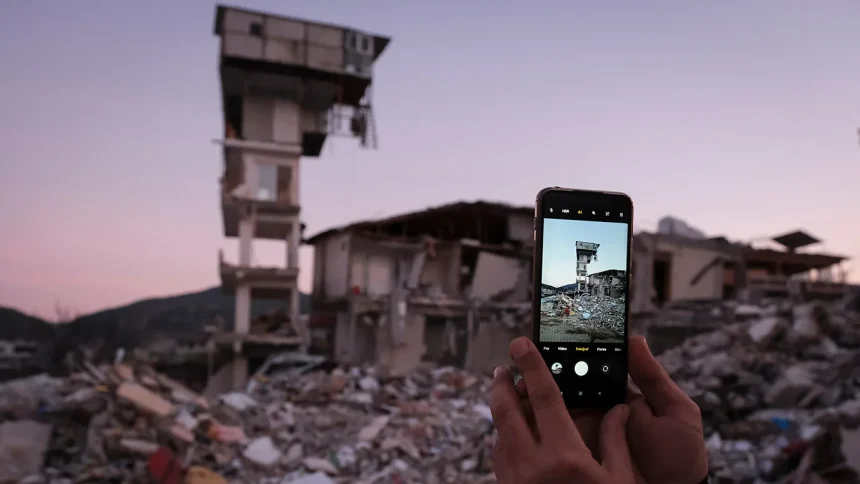When climate disasters like the Cyclone Freddy ripped through parts of Africa in 2023, it left a trail of destruction that spanned across countries like Mozambique, Malawi, and Madagascar.
More than 1,200 people lost their lives. Over 650,000 were displaced. But amid the chaos, something quietly revolutionary was at work: technology had helped save countless lives.
Today, with the planet heating at an alarming rate, climate-related disasters are intensifying. The World Meteorological Organization (WMO) reports that extreme weather events have increased fivefold over the past 50 years.
In Africa alone, over 221 million people were affected by weather and climate events between 2021 and 2025. In this crisis, technology is stepping up where traditional systems have failed.
Forecasting the Unpredictable
Predictive technologies are becoming a cornerstone of disaster preparedness. As of early 2024, 55% of countries globally reported having multi-hazard early warning systems (MHEWS) in place. Africa, in particular, had 40% of its population with access to early warning systems.
Tools like the Climate Engine and NASA’s Disaster Mapping Suite now allow meteorologists and humanitarian organisations to anticipate events like droughts and floods weeks in advance.
In Nigeria and other parts, AI models are helping track rainfall anomalies, mobile-based apps like myAgro are empowering individuals to overcome climate challenges, by providing weather updates, and risk alerts.
When floods hit Kenya in 2024, a fleet of drones were deployed to transmit live imagery to control centres, allowing rapid rescue operations. The Philippines’ Project NOAH has also become a critical tool for disaster risk reduction in Asia. The platform integrates satellite data, rainfall sensors, and mapping to provide early flood warnings.
“Satellites and sensors are crucial in helping us collect real-time environmental data,” Bimbo Ogundele told Techparley. “But the real magic happens when we translate that data into actionable intelligence.”
Artificial intelligence is no longer a distant frontier in the fight against climate change, it’s increasingly embedded in how governments, humanitarian agencies, and researchers anticipate, assess, and respond to climate-related crises.
“Artificial intelligence is already shaping how we respond to climate disasters, from damage assessment to aid logistics,” adds Susan Akinyemi, an AI engineer based in Lagos.
From analysing satellite imagery after floods to optimising relief distribution, AI is also proving to be a game-changer in emergency response systems.
Bridging the Urban-Rural Divide
Yet access to this climate tech revolution remains uneven. In many African and South Asian rural areas, internet penetration is low, energy infrastructure is fragile, and tech literacy remains a barrier.
“We can’t rely on digital alerts if phones don’t have signal or if people can’t read them,” says Adewale Omolara, a disaster relief officer in northern Nigeria. “Tech alone won’t do wonders, it must be combined with local knowledge and grassroots engagement.”
To solve this, initiatives like Floodtags are integrating text-based alerts in local languages and using community radio stations to disseminate early warnings.
In Malawi, UNICEF has supported the use of RapidPro, an open-source platform that allows governments to send mass SMS alerts to feature phones. Meanwhile, renewable-powered digital kiosks are emerging as information hubs in flood-prone areas.
Nigeria’s EcoSciGen is also tackling this divide through climate science communication and data literacy. The platform not only provides climate literacy but also equips Nigerians across various demographics with research and data skills crucial for adaptation and resilience.
“It’s important that as we are mobilising efforts to address the climate crisis, we have people from vulnerable communities equipped with knowledge to bring their learned skills to practice,” Jumoke Omodeni, founder of EcoSciGen said.
Another organisation is EcoHealthAfrica, founded by Sharon Oyelayo. The platform uses technology and social media to raise awareness about the health impacts of climate change. By connecting environmental protection with public health narratives, EcoHealthAfrica is reframing climate action as a life-saving intervention.
Private Sector and Startup Involvement
The tech sector is also waking up to climate urgency. Climatrix AI utilizes artificial intelligence to create early warning systems for climate-related disasters, helping communities prepare and respond effectively.
Another startup, ClimeCheck also develops hardware, software, and AI solutions for climate change monitoring and mitigation.
According to a report by Africa: The Big Deal, African climate tech startups raised over $325 million in 2024. Still, experts warn this is far from enough.
“While the increase in funding is encouraging, it’s still a drop in the ocean compared to the scale of climate challenges across the continent,” says Daniel Mbatha, an Accra based climate consultant. “We need sustained investment in long-term infrastructure, and grassroots-driven innovation.”
Climate Justice and Ethical Tech Use
Amid the innovation boom, concerns around climate justice persist. Who owns the data collected by drones and satellites? Are predictive systems transparent, and do they serve the communities most at risk?
According to experts, these questions are critical, especially in areas where marginalised groups face disproportionate impacts from climate events.
“If tech is not designed inclusively, it risks reinforcing the very inequalities it aims to solve,” warns Caroline Amadi, an intellectual legal expert. “To address this, frameworks must be applied to climate tools to ensure privacy, equity, and ethical use of data.”
Concerns about equity and ethical implementation are surfacing, especially in African contexts where data exclusion and algorithmic bias persist. Experts warn that while tech offers hope, its deployment must be rooted in local realities and uphold human rights.
“But without ethical AI design that accounts for African languages, data gaps, and socioeconomic realities, we risk importing systems that ignore the context they’re deployed in,” Susan added.
Climate Disasters Demand Collective Action
As climate shocks escalate, the window for meaningful adaptation is narrowing. Yet the acceleration of climate-smart technology offers a rare opportunity to shift from reactive to proactive disaster response.
But scaling this technology will require more than software. Industry leaders say it demands political will, funding mechanisms, cross-border data sharing, and community engagement.
“To truly scale climate tech solutions, we need collaboration,” Daniel added. “Governments, funders, and local communities must align to ensure these tools are accessible, context-aware, and backed by the right infrastructure.”
When climate disasters strike, the world must not just react. It must predict, prepare, and protect, and today, technology is our most powerful tool to do just that.





